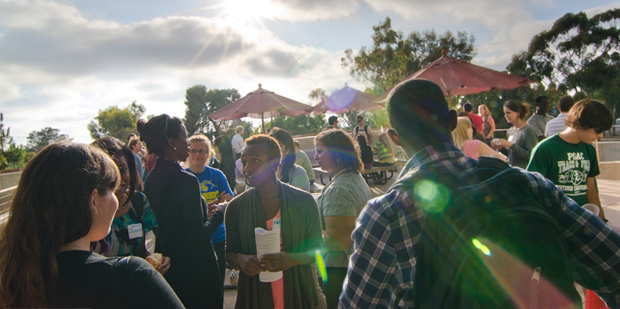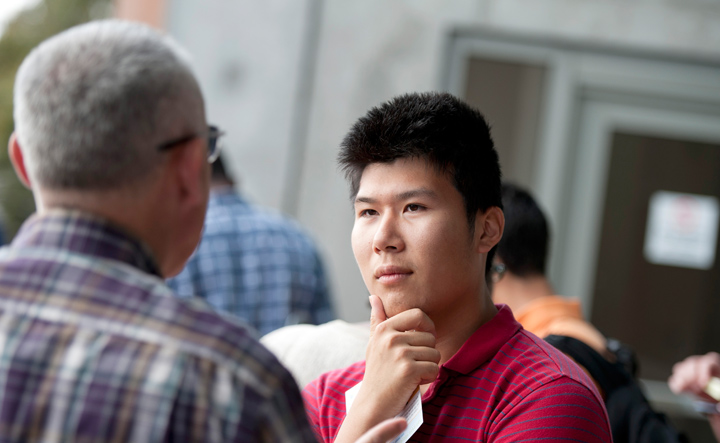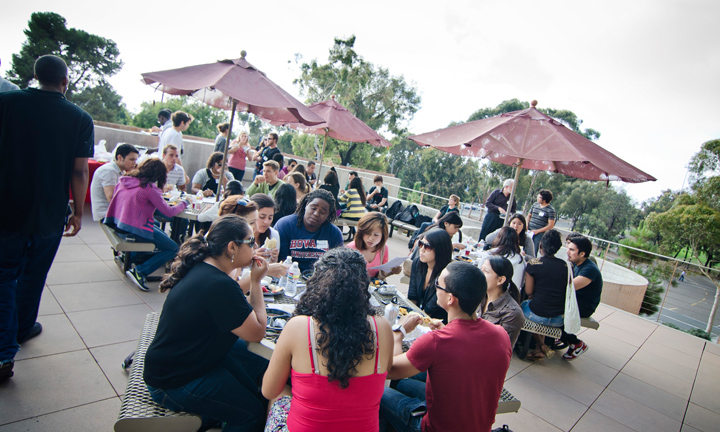By:
- Sylvia Tiersten
- Staff Writers
Published Date
By:
- Sylvia Tiersten
- Staff Writers
Share This:
Campus Leaders: Diversity is Key to UC San Diego’s Strategy

Photos by Erik Jepsen/UC San Diego Publications
In the second videotaped conversation on October 25 at the Faculty Club, Executive Vice Chancellor Suresh Subramani, Vice Chancellor and Dean for Health Sciences David Brenner and Vice Chancellor and Director of Scripps Institution of Oceanography Tony Haymet discussed the need to maintain and strengthen the impact of UC San Diego’s multidisciplinary research on society. One of the strategies is to ensure a diverse, world-class faculty at the campus.
Translating Research Into Empowering People
UC San Diego impacts communities by developing therapies for complex health-care challenges. UC San Diego Health Sciences supplements primary medical care offered by community clinics throughout San Diego County with subspecialty care. “We interact through telemedicine and by sending our residents and fellows to these clinics. Our students benefit from the opportunity to care for these patients, and the clinics benefit from our platform of specialty care,” said Brenner.

“One of our goals for the next decade is developing more effective responses to natural disasters such as the earthquake in Haiti or Hurricane Katrina,” said Haymet. “Societies have become so complex – both in the developed and developing world – that a serious natural disaster throws our communities into great disarray. This complexity principle applies whether it’s the way we get our energy or our water or even our information through the Internet.”
In an increasingly interconnected world, “We need to equip our students with all the tools they need to make a positive societal impact in any part of the globe,” said Subramani. “We have to take our best methods of teaching and critical thinking and translate this effort into empowering people to solve the problems in their part of the world, wherever that might be. We will continue to increase our reliance on foreign students and nonresidents in a broad variety of disciplines. Many of these students will travel around the world solving problems not only in the United States but in other countries as well.”
Diversity and Innovation Excellence
Diversity is a source of innovative ideas, creative accomplishments. A diverse faculty enhances the classroom experience and the research environment by raising new issues and perspectives that arise from differences of culture and life experiences. “Cultural and ethnic diversity are essential for academic excellence—and should be broadly defined in the context of research, teaching and service,” said Subramani.
“In promoting diversity at the faculty level, you need to be incredibly proactive and aggressive,” said Brenner. A new practice at Health Sciences is to define diversity expectations for every academic search committee. “In addition, our long-term approach is to identify outstanding underrepresented medical students, fellows and residents at UC San Diego and mentor them for faculty positions. Even if they don’t stay with us, they’ll become faculty somewhere else, and I think that’s really important for our reputation,” he said.
Academic Affairs put to use best practices from all over the country. “Last year we identified about a dozen hires with an emphasis on diversity in the context of teaching, research and service,” Subramani said. “We had a more successful year in enhancing diversity than the previous five years. More than 40 percent of our faculty that were hired last year would be in this category of having contributed to diversity.”

To attract a diverse student body, UC San Diego is developing strong relationships with traditional minority universities such as Howard and Morehouse. In a Health Sciences program students and fellows from Howard University frequently come to the campus and work in the Department of Pediatrics. Some of them continue on to become faculty.
Scripps Institution of Oceanography focuses on growing the pool of potential applicants—beginning at the high-school level in Southern California. Summer programs, including three-week residential stays, introduce students from a range of communities to Scripps Oceanography and its resources. “I believe we send them home with a positive experience and some knowledge about their opportunities for going to college,” said Haymet. “My hope is that five or 10 years from now, other schools across the country will hire students who got their inspiration from our summer programs.”
Reflecting on UC San Diego’s future, Haymet said: “As institutions go, we’re young and still growing. We’ve barely scratched the surface of what’s possible. We will continue to attract the next generation of thinkers and doers to campus, who will roll up their sleeves and get on with visionary problem-solving.”
“Everyone benefits from a strong UC San Diego,” Brenner added. “This institution brings greatness to the community.”
Share This:
You May Also Like
Stay in the Know
Keep up with all the latest from UC San Diego. Subscribe to the newsletter today.



